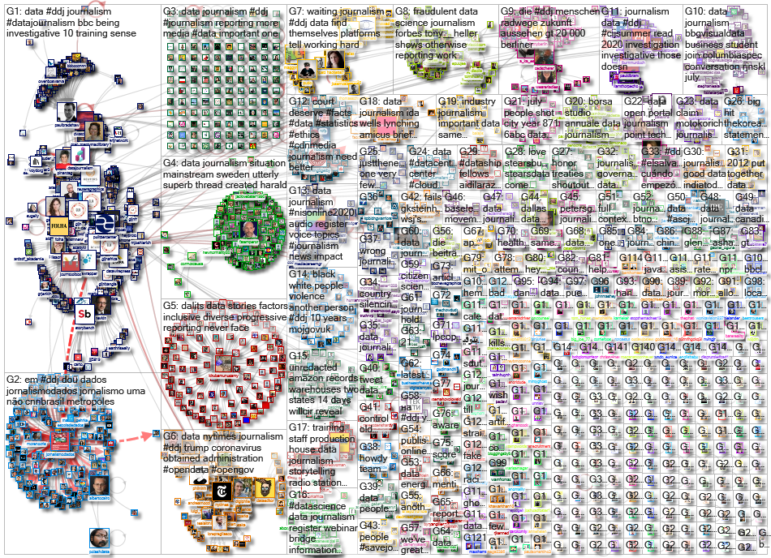The coronavirus pandemic has upended the lives of people around the world, but some communities are especially hard hit. Our NodeXL #ddj mapping from July 6 to 12 finds The New York Times analyzing data that reveals Black and Latino people have been disproportionately affected by COVID-19, The Washington Post highlighting that business relief funds for the pandemic have gone to the rich and well-connected, and Bloomberg looking at more than 120 US businesses that say the coronavirus helped force them into bankruptcy.
Racial Inequity of the Coronavirus
The New York Times sued the US Centers for Disease Control and Prevention to obtain COVID-19 data revealing that Black and Latino people have been disproportionately affected by the coronavirus across the US, and across all age groups. Here’s a podcast on this topic.
#COVID19 has made the work for racial equity in America even more urgent. https://t.co/I40RovfQpi
— Melinda Gates (@melindagates) July 9, 2020
Pandemic Cash for the Connected
After weeks of pressure from media outlets and lawmakers, the federal Small Business Administration in the US released data on the recipients of its $660 billion small-business relief program. The Washington Post examined the data and reports that COVID-19 rescue funds went to businesses owned by members of Congress, elite private schools, and a law practice that represented President Donald Trump.
— Transportation Secretary Elaine Chao’s family’s shipping business got coronavirus $$$. She is married to Mitch McConnell
— At least 8 members of Congress or their spouses received $$$, including lawmakers who directly involved in shaping regulations https://t.co/0O2weeMkeh
— Hamza Shaban (@hshaban) July 7, 2020
Silent Epidemic in Africa
A Reuters analysis found that there had been just over 420 COVID-19 tests per 100,000 people carried out across the African continent of 1.3 billion people. The lack of data due to low levels of testing suggests that the official figures do not tell the whole story of the pandemic in Africa.
This data-led piece is beautifully done: In Africa, a lack of data raises fears of ‘silent epidemic’ https://t.co/7fThddyZvH via @Reuters
— david pilling (@davidpilling) July 9, 2020
Visualizing COVID-19 Bankruptcies
Many companies in the US were already in deep financial trouble before the coronavirus pandemic led governors to shut down non-essential businesses. Bloomberg visualized more than 120 firms, including retailers, airlines, restaurants, sports leagues, a cannabis company, and an archdiocese plagued by sex-abuse allegations, that have declared bankruptcy this year and blamed COVID-19 in part for their demise.
The data, visualized: More than 100 U.S. companies that declared bankruptcy this year have blamed Covid-19 for at least part of their demise. https://t.co/D9C609bOec via @bbgvisualdata
— Reto Gregori (@RetoGregori) July 9, 2020
Knowledge Graphs for Investigative Reporting
Across the data science community, knowledge graphs have become a growing phenomenon in recent years, driving many applications including virtual assistants like Siri and Alexa. Friedrich Lindenberg, from the Organized Crime and Corruption Reporting Project, writes about how its data platform Aleph makes use of knowledge graphs to help investigative reporters analyze and cross-reference data.
NEW: People go to IMDb to find out who was in what movie and when. What do journalists look for when they come to Aleph?
OCCRP's Senior Data Editor @pudo on developing a "knowledge graph" that can illustrate key connections for investigative reporters. https://t.co/ODskowJvVP
— Organized Crime and Corruption Reporting Project (@OCCRP) July 11, 2020
Behind the Scenes of COVID-19 Visualizations
Local newsrooms across the US have been harnessing COVID-19 data, presenting it to audiences in an understandable format, and providing relevant context. To find out the process behind building these interactive visualizations, Poynter’s Kristen Hare spoke to the Tampa Bay Times about its infections and deaths by ZIP code tracker, the CalMatters newsroom about its coronavirus hospitalizations tracker, and The Boston Globe on its LiveGuide to virtual events.
How they did it: @TB_Times’ ZIP code tracker, @CalMatters' coronavirus hospitalizations tracker and @BostonGlobe's LiveGuide https://t.co/FMO1UN4c1h
— Poynter (@Poynter) July 9, 2020
Berlin’s Streets and Bike Paths
Der Tagesspiegel, in cooperation with FixMyBerlin, which lobbies for bike-friendly cities, conducted a large survey asking Berliners what the streets of the city, and especially bicycle paths, should look like in the future. Over 21,000 people participated and rated various automatically generated street scenes for their perceived level of safety — either from the perspective of a bicycle, from the car, or from the footpath.
The largest survey ever carried out on street design in Germany, 21.000 answers on what is perceived as a good street to #bike. https://t.co/4SyuOQlYJF
— Carlos Lamuela (@carloshki) July 7, 2020
Legal Threat to Data Scraping
The Markup filed an amicus brief in the US Supreme Court arguing that an overly-broad reading of the Computer Fraud and Abuse Act could endanger or limit the media’s ability to gather news, particularly in using automated data collection processes such as scraping. Read the brief here and its editor-in-chief Julia Angwin’s explanation here.
This from @JuliaAngwin on legal threat to data scraping is really important. My own best reporting example of its power: scraping ads from Armslist dot com and finding felons, DV batterers, and others selling guns. https://t.co/AkCnFiUCsC https://t.co/ihawxjBNus
— Michael Luo (@michaelluo) July 11, 2020
Amazon Safety Data
A judge in San Francisco ruled that the US Labor Department has to turn over unredacted safety records related to the warehouses of Amazon.com Inc. in two states. The files must be given to GIJN member Center for Investigative Reporting and its staff reporter Will Evans within 14 days of the federal court order. This decision could make it easier for media outlets and union leaders to gain similar injury and illness data in the future.
.@willCIR and @reveal successfully convinced a California judge to force @OSHA_DOL/@USDOL to hand over unredacted @amazon illness and injury records from warehouses in two states.
The agency has 14 days from the date of the order. https://t.co/UVeqY9XZ6W
— Fatima Hussein (@fatimathefatima) July 7, 2020
Data Journalism and Woodworking
Steven Rich, database editor for the investigations unit at The Washington Post, launched a newsletter which talks about his passion for data journalism and woodworking, and how the two intersect. Here’s the first issue.
ok fine. i did the thing. welcome to a weekly newsletter on data journalism and woodworking. i'll have fun writing it so if no one actually subscribes i still think it's worth it. first post coming monday. https://t.co/vtdybfIaZi
— Steven Rich (@dataeditor) July 9, 2020
Thanks again to Marc Smith of Connected Action for gathering the links and graphing them. The Top Ten #ddj list is curated weekly.
 Eunice Au is GIJN’s program coordinator. Previously, she was a Malaysia correspondent for Singapore’s The Straits Times, and a journalist at the New Straits Times. She has also written for The Sun, Malaysian Today, and Madam Chair.
Eunice Au is GIJN’s program coordinator. Previously, she was a Malaysia correspondent for Singapore’s The Straits Times, and a journalist at the New Straits Times. She has also written for The Sun, Malaysian Today, and Madam Chair.

